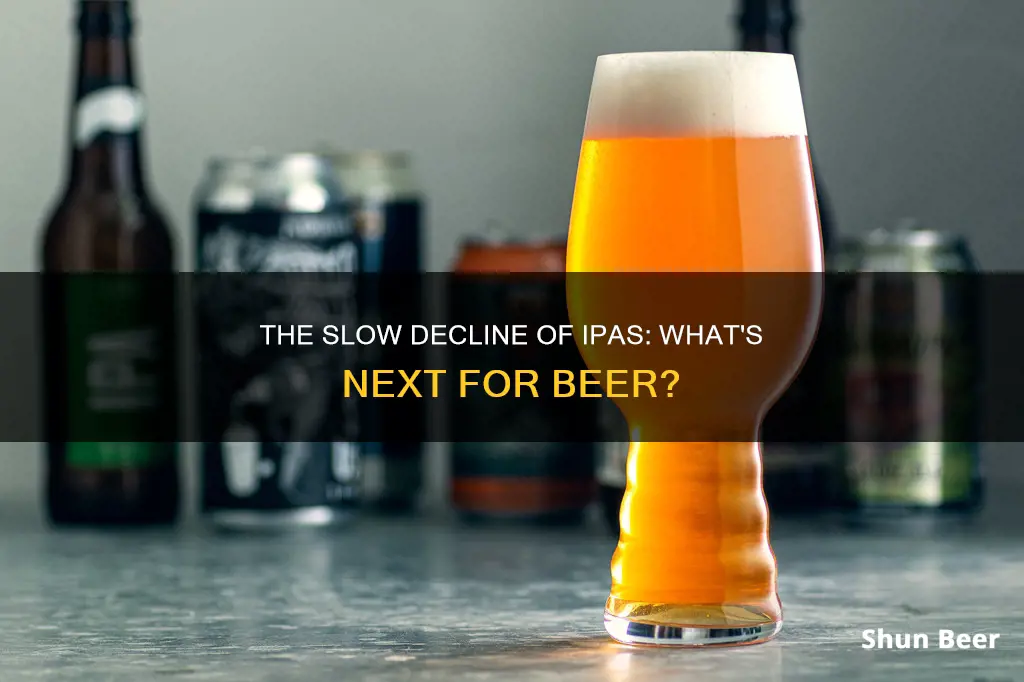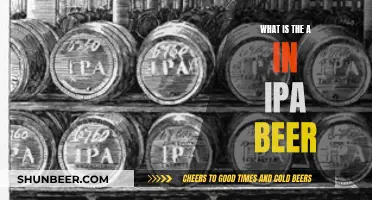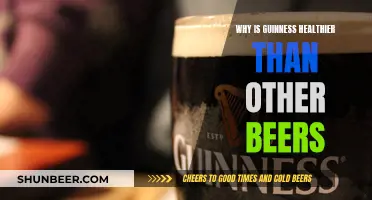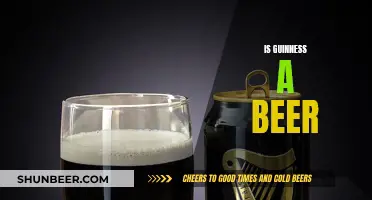
India Pale Ale, or IPA, is a hoppy beer style within the broader category of pale ales. It is characterized by its bold, bitter, fruity, and floral flavors, often with higher alcohol content. While IPAs have been popular for some time, with some sources claiming they are here to stay, others suggest they may be on the way out, as other beer styles such as sours and lagers gain popularity. So, are IPAs on the way out, and what is it about this style of beer that has captured the taste buds and imaginations of so many?
| Characteristics | Values |
|---|---|
| Acronym | IPA |
| Full Form | India Pale Ale |
| Origin | Britain |
| Alcohol Content | Varies, but generally higher than other beers |
| Flavour | Hoppy, bitter, fruity, floral, citrusy, tropical |
| Appearance | Hazy, cloudy, pale |
| Mouthfeel | Crisp, dry, smooth, soft |
| Carbonation | Low |
| Aroma | Fruity, Piney, Sweet |
What You'll Learn

The history of IPAs
The India Pale Ale (IPA) is a hoppy beer style within the broader category of pale ales. The story of its origin goes back to the late 18th century when George Hodgson, a brewer at the Bow Brewery in East London, started exporting his pale ale to India. This beer was packed with extra hops and increased alcohol content to preserve it during its long journey from England to India. The hops and high alcohol content gave it a bitter and stronger taste, making it more refreshing in the hot Indian climate compared to the dark ales and porters popular in London.
During the early 19th century, "pale ale prepared for the Indian market" gained popularity in England as exports and hopping levels increased. The first known recorded mention of the phrase "India Pale Ale" was in 1835 in the Liverpool Mercury. By the 1830s, English beer drinkers could taste this export style of pale ale, and by 1840, the India Pale Ale became one of England's best-selling beers.
The IPA continued to evolve, and by the time of World War I, it had diverged into two styles in Britain: premium bottled IPAs with an ABV of around 6.4% and cask-conditioned draught IPAs, which were among the weakest beers available. The popularity of IPAs in England waned by the start of the 20th century due to new styles entering the market and increased taxes on higher-gravity beers.
However, the early beginnings of the craft beer revolution in America during the 1970s and 1980s brought a revival of the original IPA recipes created 150 years earlier in England. American brewers added new styles of hops and increased the alcohol content, leading to the various styles of IPA available today.
Guinness Beer: An IPA or Not?
You may want to see also

The different types of IPAs
The India Pale Ale, or IPA, is a beer style that has sparked a trend that shows little sign of slowing down. The original IPAs were British and were brewed with lots of hops to survive the long journey from Britain to India during colonial times. While British IPAs are less common today, they are usually very hoppy with a light citrus character and a dry, hoppy finish. They typically have an ABV between 6% and 7%.
Over time, different types of IPAs have emerged, each with its own unique characteristics. Here are some of the most common types:
- West Coast IPA: This style is inspired by British IPAs but uses American hops, resulting in a huge citrus aroma with hints of pine. West Coast IPAs tend to be less dry and significantly more bitter than their British counterparts. They usually have an ABV of around 8%.
- New England IPA: Also known as "hazy" IPAs, these are very cloudy and have intense fruit flavours. They are often dry-hopped and have lower carbonation, resulting in a softer mouthfeel. New England IPAs typically have an ABV between 6% and 7.5%.
- Double or Imperial IPA: These IPAs have more hops and more malt, resulting in a higher alcohol content (typically over 7%. They have a strong hop flavour and are known for their floral, piney, and citrus notes.
- Session IPA: Session IPAs have a lower alcohol content (usually under 5% ABV) and a thinner body, making them perfect for drinking in multiple sessions. They have a strong hoppy aroma with a more balanced bitterness.
- Belgian IPA: This style implies the use of Belgian yeast, which imparts clove and spicy notes. They tend to be lighter in colour and have a more complex flavour profile with a higher alcohol content.
- Black IPA: Also known as a Cascadian Dark Ale, Black IPAs have the appearance of a stout but with the hoppy aroma of an IPA. They have a full body and a hint of roasted flavours, followed by a strong hoppy finish.
While these are some of the most common types of IPAs, there are many other variations, including East Coast IPAs, Sour IPAs, Milkshake IPAs, and White IPAs, each with its own unique characteristics.
Guinness Beer: Original Recipe, Unique Taste
You may want to see also

How to drink IPAs
IPAs are here to stay, but not all IPAs are the same. The acronym IPA stands for Indian Pale Ale or India Pale Ale. They are known for their high hops content, which gives them a bitter flavor. However, not all IPAs are bitter, and they can have a wide range of flavours and alcohol content.
- Let your IPA sit out for a few minutes before drinking it. The ideal serving temperature for IPAs is around 40 to 55 degrees Fahrenheit, which is much warmer than a beer pulled directly from the fridge. Allowing the beer to warm up will help to reveal its more delicate flavours and aromas.
- IPAs are best enjoyed when served in a glass rather than straight from the can or bottle. Pouring the beer into a glass releases all the lovely hop aromas.
- If you are new to IPAs, start with a more-muted variety before trying a double IPA. Double IPAs have a higher alcohol content and a more intense flavour that may be overwhelming for first-time drinkers.
- Pair your IPA with food. IPAs go well with foods such as cheese, charcuterie, and spicy dishes.
- Drink IPAs within the first three weeks of production for the best flavour and aroma. While you won't get sick from drinking an IPA four or five weeks after production, the flavour and aroma will start to deteriorate.
- If you are sensitive to bitter flavours, look for fruit-forward IPAs, such as the New England-style IPAs, which are known for their intense fruit flavours and low bitterness.
Explore the World of IPA Beers and Their Unique Taste
You may want to see also

The best food pairings for IPAs
IPAs, or Indian Pale Ales, are characterised by their hoppy bitterness. While not all IPAs are bitter, and not all of them have high alcohol content, they are often associated with these qualities.
- Cheese: A sharp Cheddar cheese can complement the bitterness of an IPA, creating a delicious contrast of flavours.
- Spicy dishes: The crisp, clean, and sharp qualities of an IPA can help to refresh the palate and balance the spice in spicy dishes.
- Barbecue: The bold and bitter flavours of an IPA can stand up to the strong, smoky flavours of barbecue dishes.
- Fried foods: The carbonation and bitterness of an IPA can cut through the richness of fried foods, providing a refreshing contrast.
- Salads: A light and crisp IPA can pair well with a fresh salad, especially if the salad contains some bitter greens or tangy vinaigrette.
- Indian cuisine: Given the history of IPAs being brewed for British sailors travelling to India, it's no surprise that they can pair well with Indian dishes, particularly those with bold spices and flavours.
When pairing IPAs with food, it's important to consider the specific style of IPA, as well as the characteristics of the dish. For example, a West Coast IPA, known for its fruity and crisp qualities, may pair better with a salad or lighter dish, while a bolder and more bitter IPA might be better suited to a hearty barbecue dish.
Prepare Delicious Corned Beef with Guinness Beer at Home
You may want to see also

How to brew IPAs
India Pale Ale (IPA) remains the most popular craft-beer style in the United States. Here are some tips on how to brew your own.
Ingredients
The most important ingredient when crafting the perfect IPA is water. Analyze your water hardness and carefully dial in your mash pH. If you're working with soft water, consider adding a bit of gypsum to take your IPA from good to outstanding.
IPA is all about hops, so your choice of hops varieties, quantities, and timing is crucial. For bitterness, look for a clean variety such as Magnum, Nugget, or Galena. For flavour and aroma hops, the sky's the limit, but getting the right blend requires experimentation. Try blending several different single malt and single hop (SMaSH) beers in your glass to approximate how they might play together in your IPA.
When it comes to yeast, you can use a classic American ale yeast such as the Chico strain, or go for an English ale strain, which tends to be less attenuative but can be engineered to finish extremely dry.
Process
Use a single-temperature infusion mash, which is perfectly suited to the well-modified malts used to brew IPAs. Boil your wort for a great American IPA—the longer the boil, the more hops additions you can add. Weigh out your hops into small bowls or cups and line them up in the order they need to go in.
Dry hops are added after fermentation and are generally chosen to complement the late kettle hops. However, you can also use them to provide interesting contrast, so consider dividing your batch and dry-hopping each version differently.
Tips
- Avoid exposing your beer to oxygen, as it spoils the beer and breaks down hop oils.
- In a big, hoppy IPA, the barley should only provide fermentable sugar, not aroma or flavour. Use pale malt as your base malt and keep specialty grains to a minimum.
- To maximize the flavour and aroma from your hops, add them at the very end of your boil and in your fermenters.
- Buy fresh, in-season hops that have been stored cold and vacuum-sealed.
- Dry-hop during primary fermentation for softer, fruitier hop character.
- Most hops benefit from being used in conjunction with other varieties. Experiment with different combinations to find what works best.
Guinness Beer: Extra Stout or Draught, What's Original?
You may want to see also
Frequently asked questions
IPA stands for Indian Pale Ale or India Pale Ale.
IPAs were originally brewed by sailors during British colonial times to preserve beer during long trips from Britain to India.
IPAs are brewed to be hop-forward, meaning they have a very direct hop flavor. They can also be bold, bitter, refreshing, and fruity.
No, IPAs are here to stay. They are one of the most popular beer styles in the UK and it is estimated that over 40% of craft beer brewed in the US can be classified as an IPA.
Popular IPA brands include Ballast Point, Dogfish Head, Alchemist, and Lagunitas.







